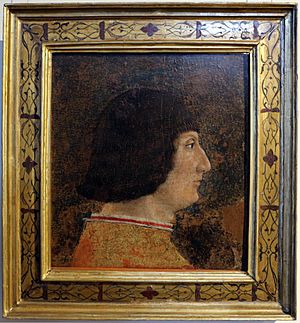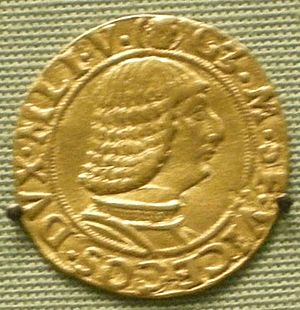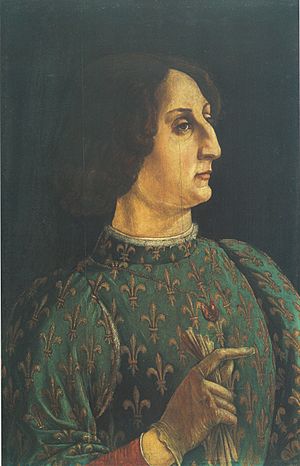Zanetto Bugatto facts for kids
Zanetto Bugatto (born in Milan in 1433, died around 1476 in Pavia or Milan) was a very important court painter in the 1400s. He was known for painting portraits. Bugatto worked for 15 years for the first two Sforza Dukes of Milan, especially Duke Galeazzo Maria Sforza and his wife, Duchess Bona of Savoy.
His art was inspired by artists from northern Europe, like Rogier van der Weyden, Andrea Mantegna, and Jean Fouquet. He met all these artists during his travels. Bugatto was one of the first Italian artists, along with Antonello da Messina, to focus almost entirely on painting portraits in the style of the Netherlands.
Bugatto helped create the official look of Galeazzo Sforza and Bona of Savoy. He did this through many portraits, medals, and coins. Even though no works signed by him still exist, many documents from his time with the Sforza family help art experts believe he painted the ducal Portrait of Galeazzo Maria Sforza (shown here) at the Castello Sforzesco.
Contents
Zanetto Bugatto's Life Story
Born in Milan in 1433, we don't know much about Zanetto Bugatto's early life. The first time we see his name in official papers is in 1458. He did a small job for the Milan Cathedral.
Early Career and Training
In 1460, Bugatto painted his first important job for the Milan court. It was a portrait of Ippolita Sforza. She was the oldest daughter of his bosses, Francesco and Bianca Maria Sforza. Ippolita needed a portrait to send to a possible husband.
After this, Bugatto traveled to Brussels. He stayed there from December 1460 to May 1463 to study with the famous Flemish painter Rogier van der Weyden. Bugatto also received money to work for Phillip the Good, Duke of Burgundy.
Working for the Sforza Court
When he came back to Milan, Bugatto started working more for his patron, Galeazzo Maria Sforza. Galeazzo was the son of Bianca Maria and the new Duke. Zanetto's jobs now included many different tasks expected from a court artist. He painted, but he also designed medals and coins. He even designed the portraits used on ducats (coins) for Duke Galeazzo and his mother, Bianca.
In 1468, Bugatto went to Paris. His job was to paint a portrait of Bona of Savoy. She was the sister of the Queen of France, Charlotte of Savoy, and was going to marry Galeazzo Maria Sforza. This trip was also good for Bugatto's money. He brought a portrait of Francesco and Galeazzo Maria Sforza with him, which he sold to King Louis XI of France.
From November 1470 to March 1471, after returning to Milan, Bugatto helped design ten solid gold medals for the Duke and Duchess of Milan.
In 1471, Duke Galeazzo and Duchess Bona of Savoy visited Mantua. They asked Bugatto to join them there. Bugatto spent three days in Mantua. While there, he saw and studied the art of Andrea Mantegna.
Later Works and Death
In 1472, Bugatto worked with Bonifacio Bemo and Leonardo Ponzoni. They created his last known finished work: frescos in the Santa Maria delle Grazie chapel. This chapel was located outside Vigevano, but it is now destroyed. In 1473, Bugatto was asked to paint a portrait of Duke Galeazzo, Bona of Savoy, and their child. This painting was for the choir of San Celso in Milan.
It is believed that Bugatto died in 1476. We don't know the exact date, how, or where he died. Records show he was active until 1476. In that year, Galeazzo tried to find a new court painter. Galeazzo's ambassador in Venice, Leonardo Botta, suggested hiring Antonello da Messina. Da Messina also painted in the Flemish style, like Bugatto. However, the Duke was killed in 1476, and there is no record of da Messina ever working for Galeazzo.
How Bugatto Learned His Art
Bugatto studied for three years with Rogier van der Weyden in Brussels. His paintings show a mix of styles from the Netherlands and Italy. This mix was something his patrons, the Sforzas, really liked.
The art guild in Brussels only allowed a master painter to have one main student at a time. So, Bugatto likely studied as a "journeyman apprentice" under van der Weyden. This type of student had fewer rules. At first, van der Weyden and Bugatto often disagreed. Bugatto even left the studio for a while until the future King Louis XI of France helped them make up. As an assistant, Bugatto probably helped with initial drawings, designing patterns, and later took on more responsibility for whole paintings.
Bugatto was very much influenced by van der Weyden's painting style. You can see this in works believed to be by Bugatto. He combined Italian styles, like profile views and dark shading, with van der Weyden's style of making figures longer and showing clear facial features. When Bugatto returned to Milan in 1463, the Sforza family noticed van der Weyden's influence. Duchess Bianca Maria Visconti even wrote a thank-you letter to Rogier. This shows how interested they were in art styles from Northern Europe.
Other Artists Who Influenced Him
Bugatto was also influenced by other important artists during his travels. When he was in France painting Bona of Savoy, he might have seen and been inspired by the works of Jean Fouquet and other French artists.
In 1471, when Duke Galeazzo and Bona of Savoy visited the Gonzaga family, they saw the Camera dipinta (Painted Room). They also saw portraits of the Gonzagas painted by Andrea Mantegna. Mantegna was a very respected portrait artist, and the Sforzas wanted their own painter to study his work. Duke Galeazzo sent for Zanetto Bugatto to come from Milan to Mantua. A week later, Ludovico Gonzaga asked Mantegna to meet Bugatto and teach him. Some historians think Gonzaga wanted Mantegna to meet Bugatto because of the gold portrait medals Bugatto designed for the Sforzas as gifts for Gonzaga.
When Bugatto traveled to Mantua, he met Andrea Mantegna. It is thought that Bugatto studied Mantegna's frescos and portraits at the Camera degli Sposi in the Palazzo Ducale, Mantua. Historians believe there was a mix of friendly competition and respect between the two artists, but no records exist about how their meeting went.
Zanetto Bugatto's Artworks
Many detailed records, like spending reports and letters, from Duke Galeazzo Sforza's court still exist today. These records tell us a lot about the art Galeazzo Sforza ordered. This helps us understand Zanetto Bugatto's art, even though most of his paintings are now lost.
Today, only one artwork is definitely known to be by Bugatto: the Portrait of Galeazzo Maria Sforza. It is kept at the Castello Sforzesco. Some historians also believe that the portrait of Galeazzo Sforza on the ducal coins from 1467 can be credited to Bugatto. However, there is still debate about who truly designed this coin.
1467 Ducats of Galeazzo Sforza
In the late 1460s, Duke Galeazzo Maria Sforza was having money problems. Despite this, Sforza wanted to leave a strong mark as Duke of Milan. So, he ordered a new set of ducal coins with his image on them. A letter from the master of the Milan mint, dated March 4, 1467, mentions Zanetto Bugatto. It says he was asked to help with this series of ducats.
The letter asks the Duke for the words to be used on the new coins. The mint master was worried they wouldn't finish the coins in time for the Duke's official ceremony on March 15. In this letter, the mint master says the Duke's image was finished after a meeting with artists, including Bugatto and the engraver.
However, art historians argue about which of two existing coins this letter refers to. They also debate if Bugatto was even the artist of either coin. Some historians point out that the Duke's portrait on both coins does not show the Flemish influences from Rogier that were important in Bugatto's other works. They use this to say that another artist created the coin portraits. These historians think Bugatto might have been an official advisor. His job would be to make sure the image looked enough like Galeazzo to show his power. Some examples of the coin most likely linked to Bugatto still exist today. The coin was made of solid gold. It had a small picture of a young Duke Galeazzo in the middle, surrounded by a 22-letter message.
1470 Sforza Medals
Bugatto designed ten medals for the Sforza family. Five had a portrait of Galeazzo, and five had a portrait of Bona of Savoy. Records show these medals were very expensive. They were almost life-sized and made of solid gold. Each one cost nearly 10,000 ducats to make.
Zanetto worked with Francesco da Mantova (the mould-maker) and Maffio Civate (the goldsmith). Together, they created the medals based on how the Duke and Duchess looked at that time. Records from 1495, after Galeazzo's death, say that Zanetto signed the back of at least one of Bona's gold medals. This showed he designed the portrait. None of these medals still exist today. We only know about them from old spending records.
Frescoes and Altarpieces
Many old account books from Duke Galeazzo's court show that Bugatto was asked several times to work on frescoes. These were for chapels in Milan and Pavia. Even though none of Bugatto's frescoes remain, and some were never finished, we know frescoes were a main type of art for him. It is thought he might have been good at painting "donor figures." These were smaller portraits of the people who paid for a fresco, shown within the larger artwork.
In 1465, Bugatto and Giacomo da Lodi checked the quality of frescoes by Giacomo Vismara and the Zavattari family. These frescoes were in the church of San Vincenzo in Prato, Milan.
In 1472, Bugatto, Bonifacio Bembo, and Leonardo Ponzoni were asked to create frescoes for Santa Maria delle Grazie. This chapel was outside Vigevano. The ducal family was shown among religious scenes in these frescoes.
One of Bugatto's last works was a family portrait for the choir of San Celso in Milan. This portrait showed Duke Galeazzo, Duchess Bona of Savoy, and one of their children.
In 1474, Bugatto competed with Bembo and Vincenzo Foppa for a job. They wanted to paint the frescoes and the altarpiece at the chapel in the Castello Sforza in Pavia. Records show the three artists' ideas for the altarpiece frame. However, they didn't draw plans for the altarpiece itself. This was because Galeazzo hadn't decided which saints he wanted painted on it.
Shortly before he died, Bugatto worked with these same two artists at Santa Giacomo fuori Pavia. They worked on a series of frescoes about the Life of Christ. This project had many problems because Duke Galeazzo was having serious money troubles and wanted to cut costs.
Artworks Influenced by Bugatto
Some artworks still exist that were not made by Bugatto himself. However, historians believe they were either greatly influenced by his work or are direct copies of his portraits.
The Portrait of Galeazzo Maria Sforza by Piero Pollaiuolo, found in the Uffizi Galleries, is one such piece. When Galeazzo visited Lorenzo Medici in Florence in 1471, it was a very important event. Lorenzo Medici would have wanted a portrait of the Duke to remember the visit. But there probably wasn't enough time for the Duke to sit for a new painting. Because of this, some historians think Pollaiuolo's portrait was made using Bugatto's work. Bugatto's painting might have been lent to the Medici family or shown to Pollaiuolo during a visit to Milan. These historians point to the influence of Rogier van der Weyden in this portrait as proof that it might be based on Bugatto's work.
Several historians have linked other artworks to Bugatto and his travels. This is because these works show a mix of Rogier-like Flemish portraits and northern Italian influences, similar to Bugatto's style. However, none of these works have been definitely proven to be by Bugatto. Art historians still strongly debate them. Some of these possibly linked works include Portrait of a Young Man (in Châteauroux), Virgin with Symbols of the Passion (in a private collection in Paris), and a panel of St Jerome (in Bergamo). Some experts have also linked two works, Virgin and Child and Galeazzo Maria Sforza (in Gazzada), to Bugatto.
See also
In Spanish: Zanetto Bugatto para niños




